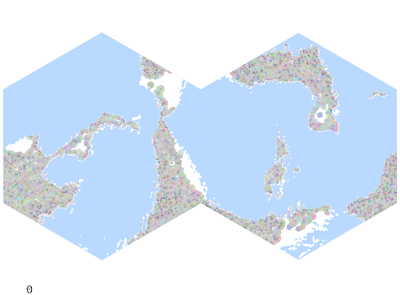The first obstacle I encounter when finding river routes is that there's no immediate correlation between AP and river vehicles (barges, small ships, etc). So we begin with some initial thoughts and observations.
Almost all relevant river travel will be by barge or similar vessel. The navigability of a river will then be dependent on the depth of the river and to some extent its velocity - some rivers may be too fast to pole or tow against. Once width becomes an issue, the point is moot anyway.
The numbers I'm getting from my velocity model (I've since tweaked the width and depth equations slightly) appear roughly commensurate with the numbers ORBIS uses. They apply a constant 65km/day rate, which is about 1.6 mph. If I only consider 10 hrs of daylight travel, we can get that number up to 3.2 mph (ah, what if I used daylight hours based on latitude as my indicator? Thoughts for later). This indicates that river travel will only be faster than dirt roads or lower. However, the cost will be much cheaper than overland travel. This kind of problem can be left with partially incomplete information, as this makes the party's decisions much more realistic.
Assume a river with downstream velocity $v = 1.837$ mph. This is equivalent to a day's journey (10 hours) of 18.37 miles. For a party traveling on land with 3 AP, that's the equivalent of 6.123 mi/AP. My assumption here is that river travel works by the same AP travel rules as travel on foot.
By the same measure, moving upstream against the current is a much slower affair. ORBIS puts upstream motion (by poling, horse-hauling, or even tacking) at 15 km/day. Therefore, we can put an upper limit on navigable rivers at where this advantage becomes moot, about 2 mph of downstream velocity.
Consider two hexes, A and B. The river flowing from A to B is 26 ft deep, 612 ft wide, and has a velocity of 1.837 mph. There is also a high road which runs throughout.
Traveling along the road with 3 AP takes 2.56 total AP (thanks to the maintained road) and 0.85 days. However, since the river is not quite fast enough, rafting down takes 3.27 AP and 1.09 days. These differences can add up for a long journey.
Say we wish to travel back from B to A. The road journey takes 0.85 days as before. But fighting against the current slows our barge to 25.6 AP, 8.5 days!
This has a few implications for travel and trade. First, there will be a severe resource asymmetry for downstream collection centers. In this case, a good might be 10 times more expensive in B than in A! Due to the upfront costs involved, trade will always move by water if possible, regardless of small disadvantages in time. Second, travel will likely also be asymmetric, as it will often be faster to raft downstream and walk back upstream. In fact, we have real-world examples of this, where cheap flat rafts would be brought down the Mississippi then disassembled in New Orleans, after which the crews would travel on land back up the river.
So it seems we will need a few different pathfinding tools:
- Routes by land only
- Routes favoring water wherever possible
- Routes combining water and land for maximum speed





